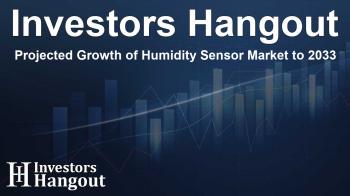Projected Growth of Humidity Sensor Market to 2033

Overview of the Humidity Sensor Market Growth
The global humidity sensor market is on a remarkable trajectory, set to achieve a valuation of approximately US$ 3,167.77 million by 2033. This significant growth from a valuation of US$ 1,320.34 million in 2024 is expected to occur at a compound annual growth rate (CAGR) of 11.56% during the forecast period. The increased demand across various industries for precise environmental monitoring and enhanced climate control drives this upward trend.
Key Applications and Innovations in the Market
Various sectors are turning their focus towards humidity sensors for accurate climate management and product maintenance. Among the most utilized types of humidity sensors are capacitive, resistive, and thermal conductivity sensors, with capacitive sensors being particularly favored for their compact and reliable nature. Notably, the automotive industry has begun integrating substantial numbers of humidity sensors into their manufacturing lines to ensure optimal climate conditions within vehicles, enhancing occupant comfort significantly.
Adoption in Agricultural Monitoring
In emerging markets, there has been a surge in the use of humidity sensors for agricultural monitoring systems, critical for preventing crop losses due to fluctuating moisture levels. From Asia to Europe, agricultural advancements utilize these sensors to ensure sustainable farming practices and improved yield.
Leading Manufacturers in the Humidity Sensor Sector
Prominent players in the humidity sensor market, such as Robert Bosch, Honeywell, and STMicroelectronics, continue to expand their production capabilities. Bosch has recently established a facility in Europe designed to produce humidity sensors at an impressive rate of 80,000 units per month. Meanwhile, Honeywell is significantly enhancing healthcare standards by supplying humidity sensor modules to numerous medical facilities across the continent.
Continuous Innovation in Sensor Technology
Innovation remains a key theme as manufacturers strive to meet the evolving demands of consumers and industries alike. For instance, Sensirion shipped over 12 million digital humidity sensors globally in the first half of 2023, sufficing the increasing market demand for high-performance devices across multiple sectors.
Market Trends and Challenges
In the context of rising technological advancements, there's a clear push towards the miniaturization of humidity sensors. This trend is boosting the integration of sensors into wearable devices, enhancing their utility and adoption further. Meanwhile, industry stakeholders are faced with challenges such as maintaining calibration consistency and ensuring performance reliability among sensors deployed in increasingly diverse and harsh environments.
Key Challenges Facing Manufacturers
The drive for cutting-edge technology has manufacturers grappling with the challenge of balancing device power constraints while delivering increased sensor data sampling rates. Additionally, adapting to intensive industrial conditions, such as high vibrations and temperature fluctuations, is crucial for maintaining sensor integrity.
Regulatory Compliance and Material Advances
Manufacturing processes in the humidity sensor market are influenced heavily by regulatory standards. In recent years, strict guidelines have been introduced requiring enhanced precision in sensor manufacturing. Leading manufacturers are investing in developing safer materials and ensuring comprehensive compliance with environmental standards to foster consumer confidence and market sustainability.
Future Directions and Market Potential
As the market moves forward, the demand for humidity sensors within various industries, including automotive and healthcare, is expected to grow substantially. Manufacturers are being urged to refine their designs continuously and adopt innovative strategies to keep pace with advances in technology and consumer expectations.
Frequently Asked Questions
What is the projected market size for humidity sensors by 2033?
The humidity sensor market is expected to reach approximately US$ 3,167.77 million by 2033.
Which sectors are driving the growth of humidity sensors?
Key sectors driving growth include automotive, agriculture, and healthcare, all seeking improved climate control and monitoring solutions.
What are the primary types of humidity sensors in the market?
The major types are capacitive, resistive, and thermal conductivity sensors, with capacitive sensors being widely favored for their reliability.
How are manufacturers adapting to regulatory changes?
Manufacturers are enhancing their materials and processes to comply with strict regulations, ensuring sensor safety and effectiveness.
What challenges do humidity sensor manufacturers face?
Manufacturers face challenges such as calibration consistency and ensuring reliable performance in varying industrial conditions.
About Investors Hangout
Investors Hangout is a leading online stock forum for financial discussion and learning, offering a wide range of free tools and resources. It draws in traders of all levels, who exchange market knowledge, investigate trading tactics, and keep an eye on industry developments in real time. Featuring financial articles, stock message boards, quotes, charts, company profiles, and live news updates. Through cooperative learning and a wealth of informational resources, it helps users from novices creating their first portfolios to experts honing their techniques. Join Investors Hangout today: https://investorshangout.com/
Disclaimer: The content of this article is solely for general informational purposes only; it does not represent legal, financial, or investment advice. Investors Hangout does not offer financial advice; the author is not a licensed financial advisor. Consult a qualified advisor before making any financial or investment decisions based on this article. The author's interpretation of publicly available data shapes the opinions presented here; as a result, they should not be taken as advice to purchase, sell, or hold any securities mentioned or any other investments. The author does not guarantee the accuracy, completeness, or timeliness of any material, providing it "as is." Information and market conditions may change; past performance is not indicative of future outcomes. If any of the material offered here is inaccurate, please contact us for corrections.
